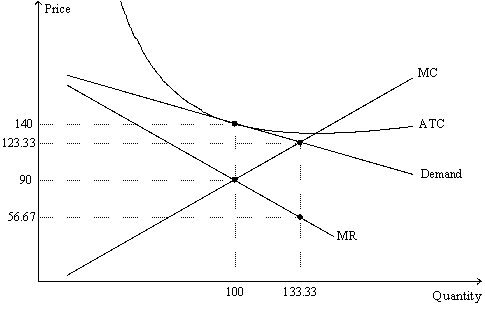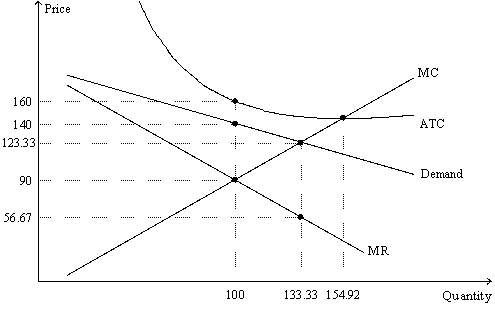A) perfect competition
B) monopolistic competition
C) oligopoly
D) monopoly
F) A) and D)
Correct Answer

verified
Correct Answer
verified
Multiple Choice
Each firm in a monopolistically competitive market
A) earns both short-run and long-run profits.
B) faces a downward-sloping demand curve.
C) cannot earn economic profit in the short run.
D) sets price equal to marginal cost.
F) A) and B)
Correct Answer

verified
B
Correct Answer
verified
Multiple Choice
Suppose the point of tangency that characterizes long-run equilibrium for a monopolistically competitive firm occurs at Q₁ units of output.This level of output,Q₁,
A) exceeds the level of output at which marginal revenue equals marginal cost.
B) exceeds the level of output at which marginal cost equals average total cost.
C) falls short of the level of output at which price equals marginal cost.
D) exceeds the firm's efficient scale of output.
F) A) and B)
Correct Answer

verified
C
Correct Answer
verified
Multiple Choice
The free entry and exit of firms in a monopolistically competitive market guarantees that
A) both economic profits and economic losses can persist in the long run.
B) both economic profits and economic losses disappear in the long run.
C) economic profits, but not economic losses, can persist in the long run.
D) economic losses, but not economic profits, can persist in the long run.
F) None of the above
Correct Answer

verified
Correct Answer
verified
Multiple Choice
Two college students,Mary and Maggie,are spending spring break in Florida.Mary buys a cup of coffee each morning at the local Starbucks rather than from one of the local coffee shops.Maggie claims that Mary is irrational because she never purchases Starbucks coffee at home,and Starbucks coffee costs more than the coffee sold by local shops.An economist would most likely explain Mary's behavior by suggesting that
A) Mary's behavior is rational, but Maggie's behavior is clearly irrational.
B) Mary's behavior is clearly irrational, but Maggie's behavior is rational.
C) the Starbucks brand name suggests consistent quality.
D) the advertising by Starbucks in Florida is more persuasive than the advertising by Starbucks in Mary and Maggie's home town.
F) A) and C)
Correct Answer

verified
Correct Answer
verified
True/False
The business-stealing externality states that entry of a new firms imposes a cost on existing firms because they lose customers.
B) False
Correct Answer

verified
True
Correct Answer
verified
True/False
Empirical evidence suggests that advertising usually leads to an increase in the price for advertised products.
B) False
Correct Answer

verified
Correct Answer
verified
Multiple Choice
A monopolistically competitive firm faces the following demand schedule for its product:  The firm has total fixed costs of $20 and a constant marginal cost of $2 per unit.The firm will maximize profit with
The firm has total fixed costs of $20 and a constant marginal cost of $2 per unit.The firm will maximize profit with
A) 6 units of output.
B) 9 units of output.
C) 11 units of output.
D) 13 units of output.
F) All of the above
Correct Answer

verified
Correct Answer
verified
Multiple Choice
In a monopolistically competitive market,
A) entry by new firms is impeded by barriers to entry; thus, the number of firms in the market is never ideal.
B) entry by new firms is impeded by barriers to entry, but the number of firms in the market is nevertheless always ideal.
C) free entry ensures that the number of firms in the market is ideal.
D) there may be too few or too many firms in the market, despite free entry.
F) A) and C)
Correct Answer

verified
Correct Answer
verified
Multiple Choice
Table 16-5
This table shows the demand schedule, marginal cost, and average total cost for a monopolistically competitive firm.
 -Refer to Table 16-5.How much profit will this firm earn at the monopolistically competitive price?
-Refer to Table 16-5.How much profit will this firm earn at the monopolistically competitive price?
A) $0
B) $5
C) $12
D) $16
F) A) and B)
Correct Answer

verified
Correct Answer
verified
Multiple Choice
Figure 16-8
The figure is drawn for a monopolistically-competitive firm.
 -Refer to Figure 16-8.When the firm is maximizing its profit,the markup over marginal cost amounts to
-Refer to Figure 16-8.When the firm is maximizing its profit,the markup over marginal cost amounts to
A) $16.67.
B) $33.33.
C) $50.00.
D) $66.66.
F) A) and B)
Correct Answer

verified
Correct Answer
verified
Multiple Choice
Figure 16-9
The figure is drawn for a monopolistically-competitive firm.
 -Refer to Figure 16-9.The firm's maximum profit is
-Refer to Figure 16-9.The firm's maximum profit is
A) $-7,000.
B) $-5,000.
C) $-2,000.
D) The firm's maximum profit cannot be determined from the figure.
F) C) and D)
Correct Answer

verified
Correct Answer
verified
Multiple Choice
A firm has the following cost structure:  If this firm is in a typical monopolistically competitive market,in the long run it will likely produce
If this firm is in a typical monopolistically competitive market,in the long run it will likely produce
A) 4 or fewer units of output.
B) 5 units of output.
C) more than 5 units of output.
D) None of the above are necessarily correct because there is not enough information to tell.
F) A) and D)
Correct Answer

verified
Correct Answer
verified
Multiple Choice
The commercial jetliner industry consisting of Boeing and Airbus would best be described as a (an)
A) perfectly competitive market.
B) monopolistically competitive market.
C) oligopoly.
D) monopoly.
F) A) and C)
Correct Answer

verified
Correct Answer
verified
Multiple Choice
A firm has the following cost structure:  If this firm is in a typical perfectly competitive market,in the long run it will likely produce
If this firm is in a typical perfectly competitive market,in the long run it will likely produce
A) 4 or fewer units of output.
B) 5 units of output.
C) more than 5 units of output.
D) None of the above are necessarily correct because there is not enough information to tell.
F) B) and D)
Correct Answer

verified
Correct Answer
verified
True/False
The market for wheat is most likely considered a monopolistically competitive market.
B) False
Correct Answer

verified
Correct Answer
verified
Multiple Choice
Which of the following conditions is characteristic of a monopolistically competitive firm in long-run equilibrium?
A) P > MR and P = MC
B) ATC = demand and MR = MC
C) P < MC and demand = ATC
D) P > ATC and demand > MR
F) A) and D)
Correct Answer

verified
Correct Answer
verified
Multiple Choice
In a market that is characterized by imperfect competition,
A) firms are price takers.
B) there are always a large number of firms.
C) there are at least a few firms that compete with one another.
D) the actions of one firm in the market never have any impact on the other firms' profits.
F) A) and C)
Correct Answer

verified
Correct Answer
verified
Multiple Choice
Table 16-2
The following table shows the total output produced by the top six firms as well as the total industry output for each industry.
 -Refer to Table 16-2.What is the concentration ratio for Industry A?
-Refer to Table 16-2.What is the concentration ratio for Industry A?
A) about 71%
B) about 81%
C) about 88%
D) 100%
F) A) and D)
Correct Answer

verified
Correct Answer
verified
Multiple Choice
Scenario 16-1 Escape Vacations has recently announced intentions to build a new hotel/resort complex in Phoenix, AZ. Assume that the hotel/resort market in Phoenix is characterized by monopolistic competition. -Refer to Scenario 16-1.As a result of the new Escape Vacations hotel/resort,tourists who stay in Phoenix are likely to experience a
A) product-variety externality, which harms consumers.
B) product-variety externality, which benefits consumers.
C) business-stealing externality, which harms consumers.
D) business-stealing externality, which benefits consumers.
F) A) and D)
Correct Answer

verified
Correct Answer
verified
Showing 1 - 20 of 497
Related Exams